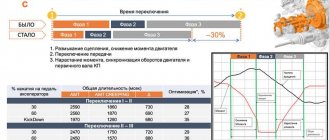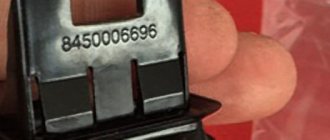Two years ago, a new product from the domestic AvtoVAZ, the Lada Vesta with a robotic gearbox, went on sale. The engineers abandoned the classic torque converter (Jatco JF414E) due to its high cost and lack of a production platform for maintenance.
AMT - this is how “robot” is designated; it was developed by the domestic design bureau of AvtoVAZ based on the mechanical type of ZF class gearbox. Of course, in terms of gear shift speed, AMT is inferior to foreign analogues from Europe and America, but it looks quite decent on the Russian market.
LADA Vesta is equipped with AMT paired with a 1.6-liter / 106-horsepower and 1.8-liter / 122-horsepower power unit. The price per copy varies from 640,000 to 850,000 rubles. AMT is also installed on Vesta SW and LADA Vesta Cross with an engine capacity of 1.8 liters. Starting price from 705,000 rubles.
Prices
In identical configurations, the robot requires an additional payment for the “handle” of 25,000 rubles, regardless of the engine - 1.6 or 1.8. But these are 2021 cars. The CVT on cars produced in 2021, if you count the difference with the base 1.6 engine with manual transmission, raises the price by 95 thousand. Quite a lot! Regarding the 1.8‑liter engine, the surcharge is less - 60 thousand rubles.
Reduced gear shift time: AMT 2.0 compared to the previous version, ms
| Percentage of pressing the accelerator pedal | From first to second | From second to third |
| 30 | 730 | 720 |
| 60 | 690 | 880 |
| 100 | 680 | 550 |
Advantages of "Robot"
The advantage of a robot over mechanics: convenience, because Only one leg is occupied, both hands are on the steering wheel.
The advantage of a robot over an automatic: it is more economical (What is the fuel consumption?) than a conventional automatic, you can tow a car, slipping is allowed on the roads, the dynamics of the “mechanics” are preserved.
It is also worth noting that the robot has protection against “crooked hands”. In other words, randomly switching the robot selector while driving will not cause any damage. In addition, Priora, like Vesta on a robot, can be started from a pusher, you can drag a trailer, tow a car - you just need to switch to mechanical mode.
The first robots were installed on the Lada Priora with a 1.6 liter engine producing 98 hp. But the robot has already been reprogrammed for the new 127 engine, paired with which Vesta will be produced.
Doesn't break anymore
I know firsthand how both options behave. I tested the CVT Vesta in the Caucasus and drove it in Moscow. And I’ve been living side by side with the robotic Vesta for 4.5 years now and have driven more than 90,000 km.
Life together with the robot did not work out right away. It is the driver who must adapt to it, and not vice versa! So, if you are looking closely at the “automated” Vesta of the first years of production (on the secondary market), keep in mind: you need to be a very calm driver with nerves of steel so that the box does not irritate you.
After about a year and a half in Tolyatti, the problem of the rapid death of the clutch was corrected. It turned out to be so gentle that even slow shifts did not help. On my car, the clutch kits lasted 20,000 and 18,000 km, and for some, the first signs of wear appeared after 5000–7000 km!
Now the third, reinforced clutch is coming to an end on the editorial car. You'll be lucky if it lasts 60,000 km (that is, up to 98,000 on the odometer). In general, you need to be prepared for quick repairs - and when buying a used Vesta, I would consider the original factory kit as a minus. Especially if it is an old model.
The Renault-Nissan 1.6 engine (113 hp) lacks a decorative cover. Let be! On a VAZ engine it is attached to flimsy pegs that are prone to getting lost. It does not protect from dirt outside and from engine noise - only decoration.
The Renault-Nissan 1.6 engine (113 hp) lacks a decorative cover. Let be! On a VAZ engine it is attached to flimsy pegs that are prone to getting lost. It does not protect from dirt outside and from engine noise - only decoration.
Interestingly, the clutches of the first and second versions signal wear differently. The old clutch begins to respond with shocks in traffic jams, and the car shakes in convulsions at the beginning of movement. The modernized one behaves intelligently, reminding of wear with exceptionally soft slipping, clearly visible in the timbre of the engine and tachometer readings. Therefore, now I will drive all the way, but I changed the previous sets preventively: I did not have the strength to endure their hysterics.
In fact about the robot: Is it worth buying a car with a Robot?
If you are interested in the question of whether it is worth buying a robot, we will tell you: sign up for a TEST DRIVE, because it is free. Only by experiencing the robot’s operation yourself will you be able to understand whether it is suitable for you or not. If it doesn’t fit, then a manual transmission package is waiting for you.
AvtoVAZ says that the gearbox is suitable for everyone; AMT has 20 different switching algorithms. But this is not entirely true.
A little from myself: If you have a harsh character and you need appropriate behavior from a car, a robot is not for you. The robot is designed for calm, leisurely driving at medium speeds with smooth shifts and saving fuel and the clutch disc. And the question immediately arises of how this transmission will perform on Vesta Sport: how much the settings will be changed, whether sportiness will appear, etc.
To go or guarantee?
How to buy a car with adequate AMT? There are two options. The obvious one is to choose version 1.8. An alternative is to go to unofficials for new firmware. Craftsmen with a laptop can reflash any Granta, Vesta or Xray for 2000–3000 rubles and 20–30 minutes. The engine and year of manufacture do not matter. We did this too. Moreover, they downloaded more advanced software to us than the factory one. It also has a sports mode, in which the engine is more willing to rev to the top, and the gearbox feels even a little more agile.
Problems with the Robot
The AMT (robot) mechanism itself is quite reliable: The box is painfully familiar to all of us, and the actuator inspires confidence. The actuator has a service life of 10 years, officially it is not repairable, but now they do everything, and repairing such an actuator is not a problem, the main thing is to lubricate it well. But there are the following “jambs” with the robot, but mainly related to the first, early models:
Long switching . As mentioned above, this is not a problem, it is a feature. Use manual mode.
Valeo clutch . As it turned out, Valeo does not match the Vesta in terms of vehicle weight, which is why current models receive a Sax clutch. Valeo quickly wore out, there was a difficult start, slippage and clutch smell were felt. The first Vesta models received the Valeo clutch.
If savings are important, then your option is 1.6 with a robot.
Robot or CVT: choose the Lada Vesta that suits youTechnical characteristics of Lada Vesta modifications
| Name | 1.6 l 16-cl. (106 hp) 5MT 1.6 l 16-cl. (106 hp) 5AMT | 1.8 l 16 cl. (122 hp) 5MT | 1.8 l 16 cl. (122 hp) 5AMT |
| Wheel formula | 4 / 2 | ||
| Motor location | Front | ||
| Body type / number of seats / doors | Sedan / 5 / 4 | ||
| Base | 2635 | ||
| DSHV | 4410 / 1764 / 1497 | ||
| Clearance | 178 | ||
| Trunk volume | 480 | ||
| Power unit | 21129 | ||
| Supply system | Injection | ||
| Number of cylinders / arrangement | 4 / in-line | ||
| Volume | 1596 | 1774 | 1596 |
| Power | 106 | 122 | 106 |
| Maximum speed | 182 | 186 | 182 |
| Acceleration up to 100 km/h | 11,2 | 12,1 | 14,1 |
| Fuel consumption (G/T/SM) | 9,3 / 5,5 / 6,9 | 9,3 / 6,0 / 7,2 | 9,0 / 5,3 / 6,6 |
| Weight | 1230 | ||
| Volume of the tank | 55 | ||
| Number of gears | 5 | ||
Reason for the squeak
The lubricant that is in the clutch actuator dries out, clumps, and no longer performs the function for which it is intended. Therefore, after 2 years, depending on the mileage and driving style, a squeak appears. Some owners do not pay attention to it - you can drive up to 60 thousand km without lubrication.
If you add new lubricant, then the Lada Vesta with the robot will work up to 120 thousand km. Then the parts wear out, especially the plastic ones, and the actuator must be replaced with a new one.
Actuating mechanism
If you completely or not completely understand what an actuator is, we will now clearly demonstrate to you what it is and why it is needed. As we noted above, it is responsible for selecting and switching gears directly on the AMT. The illustration below describes everything in detail.
- Gear selection drive.
- Electric motor.
- Gear drive.
- Electric motor.
- Gear selector rod.
You may also be interested in: Quick sale of cars of different brands
The design uses ZF electric motors from a German manufacturer.
Vesta - owner reviews after 100,000 km, all the pros and cons
Lada Vesta has been in production for more than five years and during this time it has managed to accumulate a rich database of owner reviews and service requests. Today we will look at what is remarkable about the Lada Vesta after 100,000 km. mileage, all the pros and cons of owning a car. Let's consider all engines and gearboxes.
Lada Vesta 1.6 manual transmission after 100,000 km - all the pros and cons
Lada Vesta with a 21129 engine, the volume of which is 1.6 liters, in combination with a manual gearbox, is the most reliable and durable option. In addition, as the practice of owners and services shows, it is this bundle that has the least defects. 100,000 km. for such a Vesta there is no mileage at all, therefore, on the secondary market, the Lada Vesta 1.6 manual transmission is the most preferable option. If the car is not damaged and has been properly maintained, you will not feel the difference from a new car. It is also worth mentioning the corrosion resistance of the machine. To summarize, Vesta is completely fine with her, but there are exceptions to the rules. In general, Vesta is partially galvanized, that is, all body elements are galvanized in a circle, but only on the outside, not on the inside. That's why cars bloom a lot after an accident. Sometimes it happens that even without an accident the trunk lid, or one of the rear doors, blooms if it rubs against the body.
The eternal problems of Lada, which have migrated to Vesta, are sweating shock absorbers and dead cooling pumps. The latter is true only for the 1.6 VAZ engine, since the 1.8 engine is equipped with a Korean pump from the factory, it is of different quality.
The 1.6 liter 21129 is unpretentious to oil and does not differ in its appetite, unlike its slightly larger brother. But, if you have purchased a car for a long time and want the engine to last as long as possible, it is better not to skimp on oil. Vesta maintenance schedule is 15 thousand km. But the opinion of most owners agrees that it would be better to change the oil more often. Once every 10 thousand is optimal.
As mentioned above, Vesta with 1.6 and manual transmission is a fairly durable car; the only problems after 100,000 km can be noted are problems with the cooling pump, shock absorber struts and not very good assembly (body elements rub until rye appears).
Lada Vesta 1.6 with a CVT after 100,000 km, all the pros and cons
Vesta with 1.6 on a CVT is a kind of Japanese Frenchman. The Renault K4M engine with 1.6 is very good in terms of reliability, and is also quite responsive. Of course, Vesta won’t be a hurricane with it, but it’s more than enough for a comfortable ride. It does not cause problems up to 200 thousand km. But the Jatco Jf015e variator has not proven itself very well. It's actually quite a fancy unit. It can go a long way if you drive it very slowly and change the oil in it, but in the vast majority of cases something in it still breaks down at just over 100,000 km. Most often, the sun gear breaks, the oil pump valve, the hydraulic unit fail, the metal belt breaks, the cones lift up... In general, what happens to it. There are rumors that something was improved in it especially for Vesta. It remains a sludge. Analysis of this variator removed from the West showed that this is absolutely the same variator that was installed on the Nissan and Renault models.
Lada Vesta 1.8 manual transmission after 100,000 km - all the pros and cons
The beloved 1.8 VAZ engine under the symbol 21179 was remembered by Lada servicemen for the fact that there was simply an incredible amount of requests for wild oil. This motor has a very high percentage of defects. It’s good when I can repair the engine under warranty, but if you buy a used engine after 100,000 thousand kilometers, then all the car repair needs will fall on your shoulders.
In the documentation, the plant indicates a tolerance for oil consumption of up to 600 ml. for a thousand kilometers! In fact, this is an unprecedented case; probably, you won’t find such oil tolerances on any of the modern cars! The main reason for increased lubricant consumption is oil injectors that work too actively at low engine speeds. Hence, car owners noticed one interesting feature - those who drive in city mode, at low speeds, suffer from oil loss. And those who drive mainly on the highway and rev the engine well complain about oil burns much less often. And yet, after 100,000 km. mileage, the problem with engine oil consumption often worsens.
Lada Vesta 1.8 Robot after 100,000 km - all the pros and cons
Vests with robotic gearboxes are no longer produced; they have been replaced by Vestas with a CVT. Robots have shown themselves to be extremely unviable. They have only one advantage - they save fuel. The rest is all a complete minus. They change gears with a “clunk”, rather slowly and uncomfortable. Robots do not live very long. In principle, they can compete with CVTs for first place in the “who dies first after 100,000 km” category. The robot's mechanism responsible for switching regularly fails, as does the robot's ECU. Both of them are produced by the German company ZF. Which, in general, produces pretty good classic machines, but, apparently, with robots everything is much worse. By the way, this is a single-disc robot with a dry clutch, which also often wears out.
Let's summarize briefly. If you want a really reliable and inexpensive to maintain Vesta, take a car with a 1.6 21129 and a manual transmission. At the moment this is the most well-proven modification.
See also:
The cheapest cars in Russia in 2021
It is better not to completely disassemble the actuator
There are not many plastic shavings in the case, and I did not do a complete disassembly for one reason. It is difficult to find new clutch actuators on sale. How long to wait for them and where to get them is a big question. In online stores, the actuator for Vesta is in catalogs, but not in stock. Even an official dealer cannot always provide such a spare part.
It’s a shock to me that for a domestic car that has already been in production for 4 years, AvtoVAZ did not make sure that the actuators were available. In addition, they were also installed on Prioras, which were produced earlier. You come to a large car store, and there they look at you with round eyes. The sellers don’t know what it is, they never had such parts.
If the actuator was on sale, then you could not lubricate it, but simply buy a new one. The robot box is actually comfortable. If you don’t burn it, but calmly go to work, then the robot has the right to life.
Rest
Owner reviews also cover the following points:
- the durability of the standard jack leaves much to be desired - it fails even with infrequent use;
- sometimes scratches appear on the windows of the driver and passenger - all because of the velvet and sand accumulated there;
- with the onset of cold weather, many complain about weak windshield heating;
- crickets may occur in the cabin;
- wheel caps are often lost;
- The antenna mount breaks.
What is the difference between AMT and automatic transmission
| Parameter | AMT or "robot" | Automatic transmission Jatco |
| Surcharge | 25,000 rubles | 50,000 rubles (imported parts) |
| Fuel consumption | less or like a manual transmission | more than a manual transmission by about 1l/100km |
| Clearance | like a manual transmission | because The automatic transmission dimensions are larger, the ground clearance is 2 cm less |
| Maintainability | like a manual transmission | not officially provided |
| Gear shift | only felt when shifting to a higher gear (during acceleration) | not noticeable either when accelerating or decelerating |
| Availability of manual mode | There is | No |
| Kickdown function | There is | There is |
| Adaptation to driving style | yes (more than 20 cards) | No |
Rumors about a CVT on the West
It is already known that the Renault Nissan concern, together with AvtoVAZ, is working on installing a continuously variable transmission on Vesta. To install an imported gearbox, you will need to install a new engine, most likely also foreign-made. The release date of the Lada with a CVT is not known, let’s assume that it’s not worth waiting for such a car within the next three to four years.
With a CVT, Vesta will become more economical than it is now. The ride will become smooth without changing gears. One “but” is that repairing a variator is astronomically expensive; Lada manufacturers should think carefully about this.
How to drive with AMT, operating features
With a sharp start, AMT does not shift to a higher gear for a long time and maintains high speeds. This mode of operation in the “robot” was designed from the factory so that when climbing a hill with a loaded trailer there would be no power loss.
During normal acceleration, at the moment the power breaks (when switching to a higher gear), lightly press the gas pedal. As a result, the car shifts into higher gears with a slight pick-up, which makes the ride more dynamic and comfortable.
Manual mode allows you to change gears yourself, which is convenient when overtaking and also saves fuel. It is not necessary to shift down gears manually, AMT can do this itself, just remove the gas pedal and the car will slow down and downshift on its own with a slight shift (according to science).
On LADA cars with AMT, you can start the engine from a pusher (from a cable) . To do this, turn on automatic mode and accelerate the car to 7 km/h. The transmission controller will sense the speed and activate the cable start feature.
Reverse is engaged only after complete installation, but if the speed is about 3 km/h, AMT allows you to engage first and reverse gears without a brake (just press the gas after turning on the speed). This allows you to rock the car when the car is stuck.
When starting up a hill, you can hold the car in place by lightly pressing the gas pedal.
AMT has a "transmission brake" . When descending from a mountain, press the brake pedal, and the car itself will shift down into lower gears. This is necessary to more safely hold the car on a slope.
[media=https://www.youtube.com/watch?v=xWBI9PieFMw]
So far, about 30,000 LADA cars with AMT have been sold. Every tenth car with such a transmission is sold abroad. The most popular LADA model with AMT is the Lada Vesta (Lada Granta in second place).











